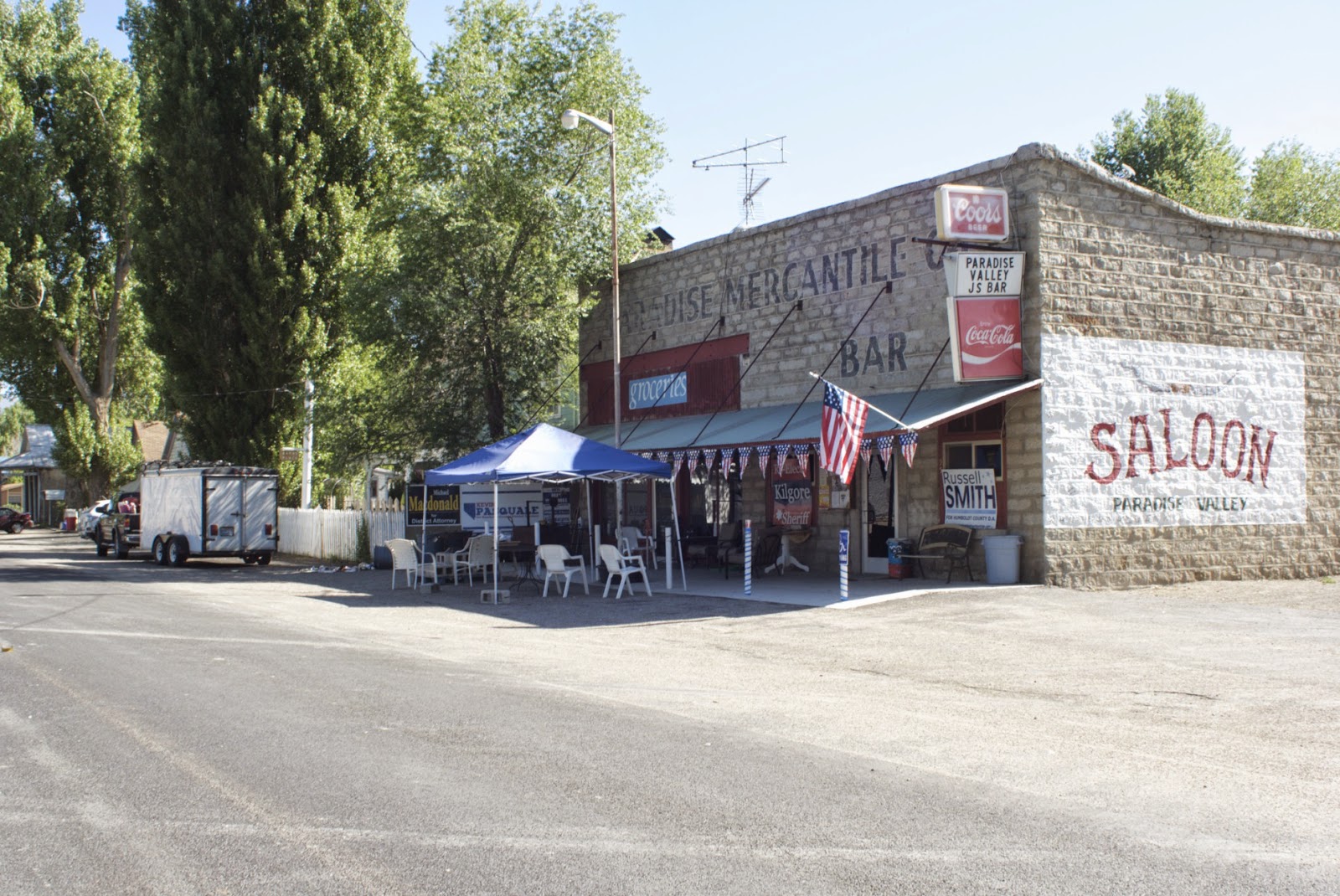 |
The old mercantile is long closed.
|
 |
This is the heart of downtown Paradise Valley on a typically quiet day.
|
North of
Winnemucca, Nevada you can find paradise, Paradise Valley that is. With a name
like that, there’s a lot to live up to. I haven’t spent enough time there to
say yea or nay, but I do know it’s a very peaceful place. And that is
definitely on my list of requirements for a paradise. It’s a sleepy, backwater
hamlet that I suspect few outside of Nevada know about and I have a feeling the
people who live there like it that way.
Besides farming and ranching, its other claim to fame is that Edna
Purviance (Purr VYE ance) was born there. Her name probably doesn’t ring a
bell. That’s because you’d have to be a silent movie aficionado in order to
recognize it. She appeared in 33 of Charlie Chapin’s productions, including the
trail blazing “The Kid” that made Jackie Coogan a major child star and was the
very first feature length film to combine comedy and drama.
 |
A three-story hotel once stood on this site. All that
is left is its red water tower. That's the Santa Rosa
snowcapped mountain range in the background.
|
Fifty-five years before Edna was born a lot had already happened in the
valley. The founder of the community, a man by the name of W.M. Gregg was
searching for a mining claim in the nearby Santa Rosa Mountains in the mid
1860s, but he changed his mind when he realized that all the land in the valley
at the base of the mountains was rich, fertile soil. So he gave up on mining,
traded in his shovel and bought a plow and went into the hay business. Others,
however, made a number of mining strikes in them thar hills and they really
helped Paradise City to become prosperous.
 |
This architecture of this church
fits perfectly with the surroundings.
|
Paradise Valley wasn’t always so peaceful. Soon after Gregg founded
Paradise City and the mines opened, trouble with the local Indians began. There were several bands in the area
made up of Paiute, Shosone and Bannock. They tried to stop the white man from
plowing up the land they considered to be theirs and to bring to an end the
contamination of streams by the mining operations. It was never a full fledge
war, but there were some pretty bad skirmishes. The military presence at newly
established Fort Winfield Scott, located near the valley, quickly ended any
further threats. With the threat of attacks gone farmers, ranchers and miners
could continue their work without fear.
After extracting close to $3,000,000 in silver, the mines petered out
and the town’s population took a nosedive. It quietly went to sleep and Paradise
City never really regained its former prosperity. The old saloon closed its
doors, as did most of the other businesses. Paradise City was on the verge of
becoming a ghost town, but the valley would soon come alive again, but this
time with cattle ranching and farming. Somewhere along the way it acquired a slight
change in its name, adopting the name of the valley.
 |
This is Nevada's famous Micca House.
|
There’s
a story that has circulated for years concerning a lost mine. It’s sometimes
hard to tell fact from fiction, but nevertheless this is what supposedly
happened in the Santa Rosa Mountains at a peak called Buckskin. It seems two
Idaho prospectors were poking around and somewhere on the southern slopes, near
a small spring, they came across an outcrop of “curious strange-looking” ore.
The two were not impressed by what they found, but just to be on the safe side
they had an ore sample assayed. And sure enough the ore was exceedingly rich.
The prospectors raced back to where they thought they had found the ore. They
searched and searched, but never found that small spring. So is the rich strike
still up there? Who knows, could be?
 |
The old weathered barn is photographed as often asthe Micca House. It just hasn't
been published as often.
|
It’s difficult to establish the exact date
when the Micca House first opened its doors. It was built in stages beginning with
an adobe section in 1871. Over the years the building was added onto. It then housed
shops, small businesses, apartments, a restaurant, a barbershop and a saloon. I
guess you could say it was probably Nevada’s first mall. In 1910 the flexible
building contained the offices of the Justice of the Peace, two physicians and
the CCC. I’ve heard the building’s name pronounced two ways, so I’m not sure
whether it’s MY-cuh, or MIC-cuh. The Micca Saloon closed long ago. however it
continues to be a popular subject and I can see why. Its image appears in many
Nevada oriented ads and magazines.
Apparently the residents don’t care to be referred to as a living
ghost town, even though there are some wonderful abandoned buildings from the
time when mining was the order of business. Those mines were replaced with
fat cows grazing on rich grass, alongside acres planted in alfalfa. There’s
even a grape vineyard. The residents would argue that Paradise Valley is very
much alive and that the only ghosts might be found over in the Micca House.
R